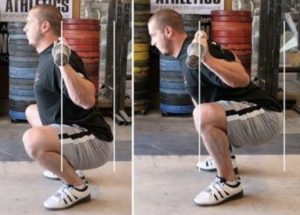
Today’s General Physical Preparedness (GPP) training includes some back squat clusters and what we will see are various different bar positions around the gym. Why? Well, there are two main reasons. The first is anatomy. Some people have preferences including and not limited to comfort and performance. The second reason is desired adaptation. 
The two classic bar positions are the high bar back squat and the low bar back squat. The image to the right is a visual demonstration of these positions (high bar and low bar, respectively from left to right). Keep in mind, both squats in the image are beautiful and technically sound.
The high bar squat affords a more vertical torso, which is particularly helpful for adaptation that more directing improves strength in the clean and the snatch for the sport of weightlifting. There’s also generally more quad recruitment in the high bar squat than the alternative.
The low bar squat keeps the bar closer to the hip making the lever shorter, which is helpful for men and women with longer torsos. The low bar squat develops and recruits the rear chain, including glutes, hamstrings, and erectors. Generally, athletes can move more weight with the low bar squat which is why it’s more popular in powerlifting.
If you’ve kept the bar in the same position for the entirety of your lifting career, consider that there are more options. Rather than judging one position over another, I’d encourage you to hold space in your mind for two different styles for two different purposes.
Logan Gelbrich
@functionalcoach
9/20/19 WOD
3x(2+2+2)
Back Squat Clusters
-Rest :30 intra rest-
Then, complete 3 rounds for quality of:
6 Box Step Ups (ea)
6 Cossack Squats (ea)
“Christine”
Complete 3 rounds for time of:
500m Row
12 Deadlifts (BW)
21 Box Jumps (24/20)

